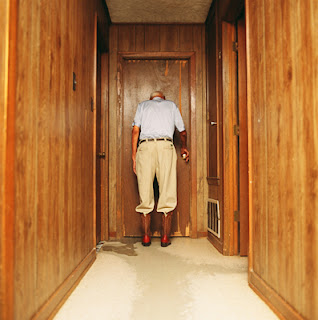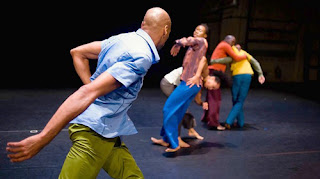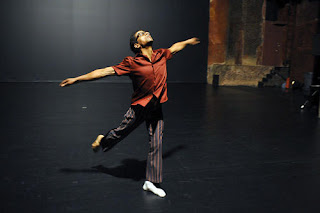 |
| Walter Carter in Ralph Lemon’s film “Sunshine Room” featured in his dance/performance piece, How Can You Stay In The House All Day And Not Go Anywhere? at OTB through 11/21. |
Review: How Can You Stay In The House All Day And Not Go Anywhere? Conceived and Directed by Ralph Lemon. Dramaturg: Katherine Profeta. Co-Created and Performed by Djédjé Djédjé Gervais, Darrell Jones, Gesel Mason, Okwui Okpokwasili, Omagbitse Omagbemi, David Thomson, Walter and Edna Carter, Ralph Lemon. Now through Sunday, November 21 at On The Boards.
How do you summarize the latest work by noted choreographer/performance/visual artist Ralph Lemon? There’s film, and dance, and video projections, and theater, and it’s a memoir and an ode to lost friends and loved ones and a celebration of other works of art and it’s a catharsis and a revelation and a journey and an end and a beginning. It’s frequently very beautiful and mesmerizing and intoxicating and it’s also frequently a bit maddening and self-indulgent and a bit fake. There were parts I liked very, very much and parts I disliked very, very much. Welcome to modern dance/performance art!
Ralph Lemon is an acclaimed choreographer and artist and a surprisingly young 58 year old. (I was shocked to find out how old he was; on stage he looked to be about 40 or so…dance evidently keeps you looking young…) He is noted not only for his finished works, but for the lengthy process involved in creating them. His previous work includes the 10 year project, “Geography Trilogy” which also used different elements in its creation and included pieces he continues to elaborate on in his newest work, “How Can You Stay In The House All Day And Not Go Anywhere?” including “non-danceable” dances and the participation of Walter Carter, the 102 year old former sharecropper who became a mentor to Mr Lemon. The death of Mr Carter earlier this year, as well as the loss of Mr Lemon’s partner, the dancer Asako Takami in 2007 were instrumental in the conception and realization of this new work.
Divided into three sections, “How Can You Stay…” opens with “Sunshine Room” a 40 minute film that is physically narrated by Mr Lemon who sits on the side of the stage and comments during the film. It opens with a scene of his mentor, Walter Carter, in a spacesuit and making a space journey in metal cage like toy rocket. The mission fails and the elderly spaceman falls to earth. Mr Lemon begins to talk about the last days with his lover Asako and how they watched the films of Yasujirō Ozu (we see a clip of his film, “Late Spring”) and Andrei Tarkovsky and we see extended clips from his film, “Solaris” and Mr Lemon relates how meaningful this film was to him and how he recreates scenes from it using Walter Carter and his wife Edna. “Solaris” concerns a man consumed by grief for his dead wife and the recreations of the film, combined with the narration from Mr Lemon are moving, and haunting, and touching. Eventually, Mr Lemon segues to talking about his art and we see images from Mr Lemon’s previous work, “Come Home Charley Patton” including a controversial dance involving Mr Lemon dancing a traditional and stereotypical buck dance and being sprayed with a fire hose, echoing the abuse suffered by civil rights demonstrators in the 50’s and 60’s. That piece ends with the other dancers in his company staging a wild, free form series of athletic moves; bumping and jumping and leaping and rolling and spinning and entwining around one another. It is exhausting but exhilarating to watch and Mr Lemon relates he loved the dance and its creation but it infuriated some audience members and alienated some of his own dancers. But, Mr Lemon was fascinated with the idea of “non-danceable” dance and reunited his dancers to create a new, longer, more involved piece and we see filmed footage of the rehearsal process that included the dancers getting drunk or high to free themselves and release their inhibitions in their movements. The film ends and Mr Lemon leaves the stage.
 |
| The dancers in “Wall/hole”. Photo by Dan Merlo |
Part two begins, “Wall/hole”. The dancers from the film are now on stage and they are recreating the dance we’ve seen in the film during the rehearsal process. It is longer and more involved and complicated than the previous versions, but still very much free form. (The best way to describe it, is to compare it to the episode of “Friends” where Phoebe convinces Rachel to start running with her every morning and Rachel is horrified to discover that Phoebe runs like a little kid, with total abandon, arms flailing and legs pumping and oblivious to the stares of onlookers…but eventually, Rachel admits, it IS fun and liberating to run like a child and joins in enthusiastically.) Ralph Lemon has admitted that audience members have walked out of this piece, not liking the free form nature of it and the lack of formality and obeying the “rules” of modern dance. I’m not a fan of modern dance and know very little about it and have very little patience for arty-farty nonsense or pretension…and, I liked this piece very much. It was fascinating to watch the combinations of dancers and the repetitions of motions and the athleticism and the vignettes played out and the physicality of it all. There is no music except the thump of body parts hitting the floor and the grunts and groans and moans and exertions of bodies in motion. It was mesmerizing and hypnotic and POWERFUL. The only downside was the running thought in my brain, “HOW do these dancers do this every night for five days in a row?” The energy required for this physical and emotion display of power is beyond my comprehension. It made me tired to think about it.
But, all good things end and the next section of the piece is the most problematic. The dancers all leave the stage, the lights dim and then we eventually begin to hear off stage sobbing. Intense, gut busting, emotionally crippling sobbing. And, it goes on, and on, and on, and on. Eventually, Okwui Okpokwasili, one of the dancers, slowly re enters the stage area and continues this act of painful and intense mourning in our view, and it continues to go on and on and on. The audience was visibly moved by this scene but in different ways. Many looked uncomfortable or confounded or irritated. Others, were emotionally involved and wiping away their own tears. I was definitely in the former camp…the scene was far too long and felt emotionally fake, despite the talents of Ms Okpokwasili. Even well performed crying by a talented, professionally trained actor is still just a recreation of the real thing despite any sense memory techniques used by the artist. For me personally, having experienced deep wrenching pain at the death of my mother and having endured the process of grieving, it felt artificial and false and demeaning to MY emotional connection to those feelings and experiences. But, I have to admit, that was the intent of Mr Lemon. He’s boldly stated he WANTED people to be stirred up by the piece and experience strong emotions about it, positive OR negative. It’s a bold artistic statement but I’m not entirely convinced it’s a necessary artistic statement…some of us DON’T need to be reminded of grief…we might experience it everyday with being reminded theatrically.
We continue with a lighter air...a video projection of Mr Lemon in a bunny suit interacting with a dog, a flamingo, a cow, and other animals. It was charming. It was sweet. It was a nice relief after the sobbing. I don’t really know what it means. Maybe we’re not supposed to.
 |
| Ralph Lemon. Photo by Stephanie Berger. |
The night ends with Ms Okpokwasili and Mr Lemon in a dance…a duet that’s not quite a duet, each wrapped in their own world. It’s a small dance, a series of small moments and moves. A recurring theme: Mr Lemon and the removal of a sole sock and the eventual return of the sock to his foot. It’s a delightful nuanced and subtle piece and a charming way to end the piece.
But, I think my favorite thing about this work is the creation of the title. Mr Lemon was teaching a class to some middle school aged kids that involved them having to research their family trees as part of the project. One of the students admitted in class that they spent 18 hours on the computer one day working on the project. A horrified classmate responded: “How Can You Stay In The House All Day And Not Go Anywhere?!!?!”
As someone who has suffered grief, AND as someone who writes for a website, I can relate to that question on two very different levels. And, appreciate them.
– Michael Strangeways











